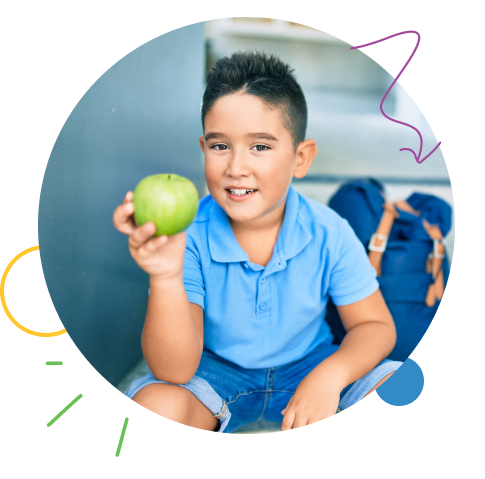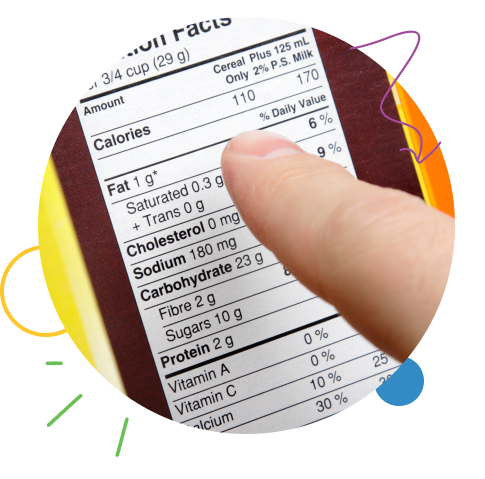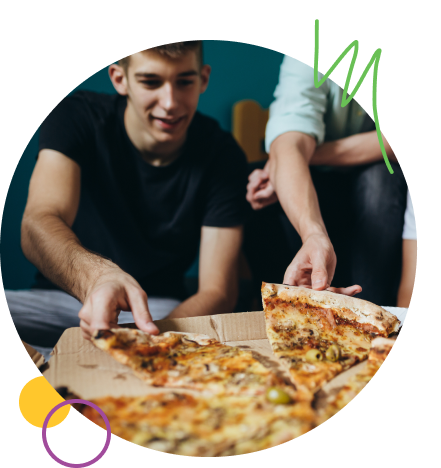The NDSS is administered by Diabetes Australia
- /
- Eating and drinking
There’s no such thing as a special diet for people with diabetes. You can enjoy the same food as everyone else!
Some young people say that living with diabetes makes them better at making good food choices. As a young person with type 1 diabetes, you will become an expert on eating a balanced meal plan, keeping fit, and looking after your health.

Choosing healthy foods is important for everyone, not just when you have diabetes. It helps you feel good and keeps your tummy happy too.
It’s a good idea to see a dietitian if you can, so they can help you with food plans designed especially for you.
Understanding the five food groups is a great place to start for planning a balanced eating style that keeps you strong, healthy, and full of energy.

Grains (cereals)
Grains give you the energy to play and learn. Choose whole grains like brown rice, wholemeal bread and wraps, crackers, pasta and noodles, or whole grain cereal for the most benefits.
Vegetables
These colourful foods give you essential vitamins and minerals to keep you healthy. They can be fresh, frozen or canned. Try to eat a variety of different colours each day!
Fruit
Fruits are sweet, juicy, and full of vitamins. They’re great for snacks or desserts. Just remember, fresh, canned (with juice drained) or frozen is best.
Dairy and alternatives
This group helps build strong bones and teeth. Pick things like reduced-fat milk, yogurt, and cheese. If you don’t eat dairy, choose other options like plant-based milk such as soy or almond milk with added calcium exist.
Meat and alternatives (proteins)
Protein helps your body grow and repair itself. Choose lean protein foods like fish, chicken, eggs, tofu, lentils, chickpeas, and nuts.
Carbohydrates
Carbohydrates (also known as carbs) is the name that we give to the group of foods that our body turns into glucose. Carbs are found in all kinds of foods, like bread, pasta, fruits, and vegetables. They are also found in drinks, like soft drinks, milk, and fruit juice.
Fibre
Fibre is a part of food that doesn’t completely breakdown – think the skins on fruit or veg, or the stringy bit on celery. Fibre helps keep your digestive system healthy, and it slows down the release of glucose into your blood. This is important because it helps manage blood glucose levels.
Fats and oils
Healthy fats and oils are an important part of a balanced meal. It’s important to consider both the amount and the type of fat you eat. The main types of fat found in food are saturated and unsaturated fats.
Some carbs are longer-lasting and help your blood glucose and energy levels stay steady. Some carbs are fast-acting. They raise your blood glucose levels quickly and leave you feeling less satisfied.
Carbs are found in any type of bread. They are also found in cereal and grains.
The vegetables with the most carbs that will impact your blood glucose levels are potato, sweet potato, taro, and corn. You may know them as “starchy vegetables”.
These vegetables contain carbs no matter how you cook them. Potatoes, for example, can be mashed, roasted, boiled, or fried. Even potato crisps contain carbs. You will also see a slow rise in your blood glucose levels with legumes such as lentils, chickpeas, kidney beans and pulses.
There are lots of vegetables (fresh or frozen) that contain little or no carbs they are sometimes called “free foods”. They include your green leaf vegetables or salads or non-starchy vegetables.
Did you know carrots, peas, and pumpkin fall into the “non-starchy” group as they contain only a very small amount of carbs.
All fruits contain carbs, including fresh fruit, tinned fruit, dried fruit, and fruit juice.
Did you know a serving of berries such as strawberries and blueberries contain very little carbs and will have little effect on your blood glucose levels?
Milks including full fat, reduced fat and skim milk all contain carbs. Foods that are made from these milks also contain carbs.
This is a tricky one! Cheese, butter and cream don’t contain carbs even though they are made from milk. The lactose is fermented off during the making of these foods.
But they contain high amounts of saturated fat which will impact other important aspects of your health such as heart health.
Protein foods have very little carbs.
Did you know legumes can be a protein source for those that prefer to not eat animal sources of protein?
These all contain carbs. But they’re different to the ones found in the above five foods groups. They’re usually sweetened with added sugar. ‘Sometimes foods’ have no health benefits compared to the naturally sweetened and nutritious food in the five food groups, such as fruit.
GO foods give you energy to run, play, think at school, and be alert and happy. GO foods are grain foods such as rice and oats. They’re also foods made from grains such as pasta, bread, and breakfast cereals.
GO foods affect your blood glucose levels in different ways. GO foods are carbs. Making sure you have a healthy amount of GO foods at each meal is important. They stop blood glucose levels getting too low or giving you a hypo (hypoglycaemia). They give us energy and helps your brain with thinking clearly.
GROW foods are needed to help you grow. GROW foods are foods from animals such as lean meat, eggs, milk, cheese, and yogurt. They also include foods such as baked beans, chickpeas, nuts and tofu.
GLOW foods also give you energy and help stop you getting sick. GLOW foods are fruits and vegetables. They’re also carbs. They’re our most colourful foods, and they’re what keeps us glowing on the inside and out!
SLOW foods are high in sugar, salt, and fat. Try to eat less of these foods an opt for foods from the grow, go or glow section. Some of these foods are useful to treat hypos when needed.
Now that you know about the different food groups your body needs everyday, let’s build a balanced meal.
There is no “one-size fits all” special meal plan for people with diabetes. Just like everyone else you need to make smart choices about foods you eat everyday, and foods you eat sometimes, and in small amounts.
When this happens, they have higher kilojoules, saturated fat, added sugars, or added salts. It’s ok to eat these only sometimes and in small amounts.
These include:
Remember, it’s essential to drink plenty of water! Beware of sweetened drinks because they have a lot of added sugar which can make it hard to manage your blood glucose levels.
0 tsp
8-10 tsp
8-10 tsp
8-10 tsp
13-15 tsp
13-15 tsp
16-20 tsp
16-20 tsp
16-20 tsp
16-20 tsp
Labels on packaged foods give information that can help you make better food choices. This can help you manage your diabetes.
Sometimes the packaging makes foods seem healthier or more nutritious than they really are. This can make shopping very confusing. The good news is that you can check them using nutrition labels.

You know the foods that keep your body going and the tips to a balanced eating style. Now let’s put your knowledge into practice in the real world.
When you have type 1 diabetes, deciding what to eat can be a challenge when out with friends, or needing food in a hurry, but you can still enjoy eating out. The key is to plan ahead and knowing what to look for in menus.

If you’re going through a fast food chain drive-through, in a cafe or restaurant, or ordering home delivery, here’s the best tips for eating well and feeling well.
Check out the online Carb Counting program on ndss.com.au. You will learn what foods contain carbs, and different ways to count the carbs in the foods you eat. You can access the online Carb Counting program anytime and anywhere, and you can even download it as an app for use on your device. Talk to a dietitian for more information on eating well, carb counting and reading nutrition labels.

Talk to a dietitian for more information on eating well, carb counting and reading nutrition labels. To find a dietitian near you go to the Dietitians Australia website.
Call the NDSS Helpline 1800 637 700 and ask to speak with a dietitian.